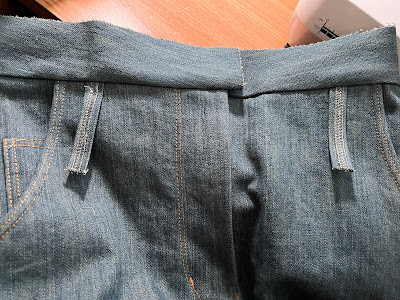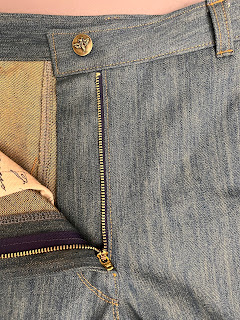Barrel, lantern, horseshoe, balloon--different names that refer essentially to the same style of jeans that are currently trending. The common denominator is a wide silhouette that tapers at the hem to give that unique shape. I became obsessed with it after seeing a pair of Sid jeans by Tibi early last year. Looking for a sewing pattern to replicate it was not that difficult. I just googled "barrel pants sewing pattern" and a number of choices came up. It was narrowing them down to one that proved time consuming.
So you may wonder how I eventually decided on the Style Arc Kew pattern. Here are the reasons:
Shape
The barrel silhouette in this pattern is a result of shaping not just along the sides. The back is made up of two center and two side pieces all of which are gently curved along the lengthwise edge. In above photo, 1 refers to the side back, 2 is center back and 3 is front piece.
A long dart on the center of the front near the bottom hem contributes to the tapered look.
Fit
Waistband
 |
It is flat and shaped with no elastic. Some barrel pants pattern achieve their shape because of the excess fabric from the elasticized waist. |
Design Details
 |
Diagonal front pockets with coin pocket on right side. Opportunity for applying metal rivets not just as accent but also as corner reinforcement. |
Essential tools of the trade
For topstitching, I did not backstitch at the beginning and end. Backstitching usually creates a mess of threads on the wrong side (at least in my case) and the start/stop points can be pretty obvious when using thick thread. Instead, I pull the topstitching thread to the wrong side, knot together with the bobbin thread and hide them within the seam. I also apply Fray Check sparingly. In above example, I did not do the knot since the edges were serge-finished and sewn to the main pocket.
 |
| Fly front |
 |
| Front lower dart and hem. |
 |
| Zipper edge, waistband, belt loops. |
 |
| Center/Side back seams. This is a view of the wrong side. I serged the seams together, pressed them to the sides and used double topstitching on the right side. |
 |
| I eventually finished the exposed short raw edges of the belt loops with tiny zigzag stitches. Nothing worse than threads fraying after using belt on jeans. |
 |
| Hard to see here but those are the tiny zigzag stitches. |
 |
| I sewed the top of the belt loop with straight stitches first before doing final topstitching. |
 |
| View of the finished belt loop. |
Although I have already sewn the Kew pants many times before, I am really proud of how this latest one turned out. I love the finishing details that mimic a traditional five-pocket jean. And I love the toned down version of my barrel jeans! All that's missing is a proper jean label.
Here are some modeling shots:)







































































